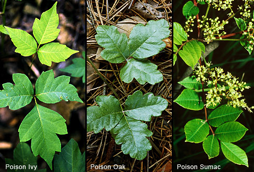

Beware Poisonous Plants
Although the weatherman seems to have pulled an April Fool joke on us this week, it really is spring. And, as we know, in spring a young man’s fancy lightly turns to thoughts of fishing. I’ve been a fisherman since I could hold a cane pole and catch bream in Arkansas. When I was 13 I caught more than fish, I caught poison Ivy. It’s a catch I’ll never forget. Everyone seems to getting outside more now so I thought I’d share some myths and facts from WebMD about poisonous plants.
Facts & Myths about Poison ivy, poison oak, and poison sumac.
They Grow Everywhere:
Fact. Poison ivy, poison oak, and poison sumac grow in wooded or marshy areas throughout North America. The plants aren’t really poisonous. They have a sticky, long-lasting oil called urushiol that causes an itchy, blistering rash after it touches your skin. Even slight contact, like brushing up against the leaves, can leave the oil behind. Poison ivy and poison oak grow as vines or shrubs. Poison sumac is a shrub or tree.
Leaves of Three, Let It Be:
Myth. Poison ivy is the only one that always has three leaves, one on each side and one in the center. They’re shiny with Smooth or slightly notched edges. Poison oak looks similar, but the leaves are larger and more rounded like an oak leaf. They have a textured, hairy surface. There may be groups of three, five, or seven leaves. Poison sumac leaves grow in clusters of seven to 13 leaves, with one by itself at the end.
The Rash Shows Up Right Away.
Myth: It forms within 24 to 72 hours of contact, depending on where the plant touched you. It usually peaks within a week, but can last as long as 3 weeks. A rash from poison ivy, oak, or sumac looks like patches or streaks of red, raised blisters. The rash doesn’t usually spread unless urushiol is still in contact with your skin.
Don’t Touch the Leaves. You’ll Be OK:
Myth. It’s usually safe to breathe where poison plants grow. But if you burn them in your yard, the smoke could cause problems. When poison ivy leaves burn, they put out chemicals that can bother your eyes, nose, or lungs. You may need to see a doctor if you breathe the smoke. He’ll prescribe steroids to control your symptoms.
Clothes Keep You Safe:
Fact. Keep your skin covered to avoid contact with these plants. Wear a long-sleeved shirt, long pants, gloves, and closed shoes if you’re in an area where they grow. Tie the bottoms of your pants legs or tuck them into your boots. Wear gloves when you handle bagged mulch or bales of pine straw. Keep a pair of shoes just for outside use and keep them outdoors.
The Oil Stays on Your Skin:
Fact. Urushiol begins to stick within minutes. If you know you’ve made contact with poison ivy, oak or sumac, wash the area with lukewarm water and soap ASAP. If there’s no water, rubbing alcohol or alcohol wipes can remove it. Keep the area cool, dry, and clean. Wash your clothes and clean your boots or shoes. Hose down any garden tools that might have touched the plant.
Home Remedies Clear Up the Rash:
Myth. But using them along with over-the-counter medicine can ease the itch and keep you more comfortable. Once a rash appears, keep it clean, dry, and cool. Calamine lotion, diphenhydramine, or hydrocortisone can help control itching. Cool compresses or baths with baking soda or oatmeal can also soothe the rash. Don’t scratch. It won’t spread the rash, but can cause scars or infection. Your doctor may suggest other treatments for your symptoms.
The Rash Is Contagious:
Myth. If someone in your household has poison ivy, oak, or sumac, you can’t catch it from them, even if you come into contact with the blisters. Just because you’ve never had a rash from one of these plants doesn’t mean you’re in the clear. Most people—about 85%–are allergic to urushiol. You can be infected by it at any age.
You Won’t Need to See a Doctor:
Myth. See your doc if the rash is close to your eyes or is widespread over your body. If needed, he can prescribe medications you take by mouth that will help with swelling and itching. Head to the emergency room if you have severe reactions in addition to the rash, like nausea, fever, shortness of breath, extreme soreness at the rash site, or swollen lymph nodes. Call 911 if you have any trouble breathing or feel faint.
Pets Don’t Get the Rash:
Fact. A dog’s or a cat’s fur usually protects its skin from urushiol. But it can stay on the fur and rub off on you. If your pet explores areas where these plants are found, bathe him with soap and cool water. Be sure to wear gloves.
Use Any Method to Control Plants:
Myth. Don’t burn poison ivy, oak, or sumac. Particles of urushiol remain in the smoke and can aggravate your eyes, nose, and respiratory tract, and can land on the skin. Instead, dress appropriately and dig out the plants, getting as much of the root as possible. Put them in a plastic bag and throw it away. Have someone else do this if you’re super-sensitive to the plant. Some plant killers may work. Read the label carefully and use it at the right time of the year. Be careful – urushiol remains active, even on dead plants.
https://www.webmd.com/skin-problems-and-treatments/ss/slideshow-poison-plants-guide
Here’s an excerpt from the famous poem cited above.
Locksley Hall
8 couplets down:
In the Spring a fuller crimson comes upon the robin’s breast;
In the Spring the wanton lapwing gets himself another crest;
In the Spring a livelier iris changes on the burnish’d dove;
In the Spring a young man’s fancy lightly turns to thoughts of love.
Then her cheek was pale and thinner than should be for one so young,
And her eyes on all my motions with a mute observance hung.
And I said, “My cousin Amy, speak, and speak the truth to me,
Trust me, cousin, all the current of my being sets to thee.”
Cousin??!!! No wonder the boy writes so well. He must be from Arkansas too.

